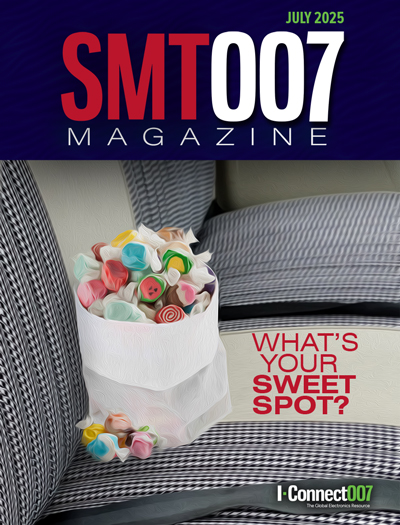-

- News
- Books
Featured Books
- smt007 Magazine
Latest Issues
Current Issue
Supply Chain Strategies
A successful brand is built on strong customer relationships—anchored by a well-orchestrated supply chain at its core. This month, we look at how managing your supply chain directly influences customer perception.

What's Your Sweet Spot?
Are you in a niche that’s growing or shrinking? Is it time to reassess and refocus? We spotlight companies thriving by redefining or reinforcing their niche. What are their insights?

Moving Forward With Confidence
In this issue, we focus on sales and quoting, workforce training, new IPC leadership in the U.S. and Canada, the effects of tariffs, CFX standards, and much more—all designed to provide perspective as you move through the cloud bank of today's shifting economic market.
- Articles
- Columns
- Links
- Media kit
||| MENU - smt007 Magazine
Material Effects of Laser Energy When Processing Circuit Board Substrates During Depaneling
July 27, 2016 | Ahne Oosterhof, LPKF Laser & Electronics North AmericaEstimated reading time: 13 minutes
Figure 12: Comparing temperatures in different materials.
Because different efforts are needed to cut through different materials, different cutting times result and for the more difficult situations higher temperatures are being measured. Still the temperatures at a distance of about 0.1 mm remain quite acceptable.
Quality vs. Time
As mentioned, the laser beam does apply some heat to the workpiece. In order to minimize the impact of the heat the beam is scanned multiple times over the cutting path to distribute and minimize heat build-up. For this reason, the beam control system allows adjustment of the movement speed and beam power, but it is also possible to insert rest periods between cutting paths. These rest periods are more important when the cutting path is short and the beam would be back in the same location more quickly.
When board layout and component placement are done well away from the sides of the individual boards, the cleanliness of the sidewalls is of less concern and the laser parameters can be selected for maximum cutting speed, meaning higher beam power, faster beam speed and shorter rest periods between cutting paths.
On the other hand, when the cleanliness of the sidewall is critical, more care has to be taken in the selection of the machine settings. Figure 13 presents a visual difference between these two strategies.
Figure 13: Visual difference between high quality/low speed and fast speed/lower quality.
Surface Analysis
To determine the spectrum of chemical components left on the cut surface the energy dispersive X-ray (EDX) analysis method was performed. For reference a routed sidewall was carefully polished and cleaned to show the normal composition of a board. Spectral lines from four chemical components are displayed in false color for the polished sidewall (Figure 14) and for the laser cut sidewall (Figure 15). The variation is too small to expect significant issues.
Figure 14: Polished and cleaned sidewall.
Figure 15: Untreated laser-cut sidewall.
Page 4 of 6
Testimonial
"We’re proud to call I-Connect007 a trusted partner. Their innovative approach and industry insight made our podcast collaboration a success by connecting us with the right audience and delivering real results."
Julia McCaffrey - NCAB GroupSuggested Items
LPKF Increases Revenue in the 1H of 2025 Despite global uncertainties
07/24/2025 | LPKFThe LPKF Group increased revenue by 7.2% to EUR 59.2 million in the first half of 2025 and achieved an almost balanced adjusted EBIT* (earnings before interest and taxes) of EUR -0.7 million.
Altus, Danutek Expand Partnership with LPKF to Offer Laser Plastic Welding Solutions
05/21/2025 | Altus GroupAltus Group, a leading supplier of capital equipment and service support for the electronics manufacturing sector in the UK and Ireland, and its sister company Danutek, which serves Central and Eastern Europe, are expanding their technology offering through an enhanced partnership with LPKF, a specialist in laser-based manufacturing solutions.
LPKF Reports Results for Full Year 2024
03/27/2025 | LPKFThe technology company LPKF Laser & Electronics SE published today its annual report for 2024. Despite the challenging economic conditions for the German mechanical engineering industry, LPKF was able to maintain its revenue slightly below the previous year's level at EUR 122.9 million.
Queen's University Belfast Enhances RF Research with LPKF ProtoLaser R4
03/26/2025 | LPKFThe Centre for Wireless Innovation (CWI) at Queen's University Belfast relies on the state-of-the-art LPKF ProtoLaser R4 to conduct RF research with high-precision structuring of sensitive materials.
Real Time with... IPC APEX EXPO 2025: LPKF's Advancements in Laser Depaneling Technology
03/25/2025 | Real Time with...IPC APEX EXPOIn this recent interview, Jake Benz from LPKF Laser and Electronics discusses advancements in laser depaneling technology, focusing on speed and quality. He highlights the previous negative reputation of laser depaneling and shares insights from nearly two decades of experience. As customer needs evolve, traditional companies are exploring laser technology.


